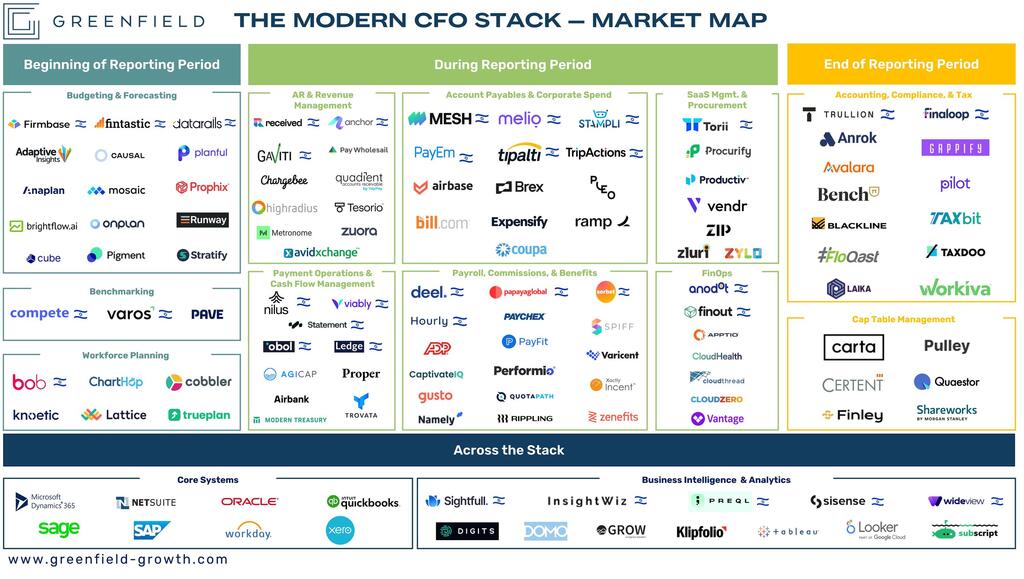
Mapping the modern CFO stack
Despite all the innovation in the CFO software space, we are still a long way from fully automated and digitized financial processes. But the new wave of innovation that has emerged brings excitement around the future of the modern CFO stack, write Raz Mangel and Ortal Sasson-Hendin of Greenfield Partners
Managing finances is a core part of every business. Whether it be a global enterprise or a small business, every company needs to plan, track, and report its financials on an ongoing basis. While that may seem like a trivial endeavor, an ever-changing global business landscape and advances in technology are creating increasing complexities for CFOs to stay on top of their businesses. “Simple” tasks such as paying salaries, tracking expenses, managing cash and revenues, analyzing metrics, and paying suppliers are now anything but simple.
Moreover, events like the global pandemic, the recent market turbulence, and a shortage in skilled talent are increasingly exacerbating the problem and pushing organizations to maximize productivity across all enterprise functions. Finance is no exception.
These challenges are subsequently driving CFOs, who have in some instances invested the majority of their time overseeing basic financial tasks such as bookkeeping and accounting, to take on greater strategic roles and embed themselves and their teams across all departments in order to support critical business decisions. After all, CFOs are essentially charged with the responsibility of constantly optimizing growth and efficiency; without the proper tools and visibility they cannot do so effectively.
While their challenges grow, finance departments have historically lagged behind other functions in the organization when it comes to technological innovation, as most companies still rely on manual workflows for a large portion of their tasks. The aforementioned trends, combined with this lack of technology, have now reached a boiling point which is serving as a strong catalyst for the rise of a new class of tools, powered by modern advances in technology - “The Modern CFO Stack”.
The modern CFO software stack map – understanding the landscape
The universe of software impacting the office of the CFO is broad and can be largely segmented into four key groups – beginning, during, and post reporting period, with the fourth segment comprising of the systems across the stack. While not all solutions directly target the CFO as a buyer, to a certain extent they all provide solutions that are integrated into the finance team’s workflows. Of note, we have not included in our map the technologies and infrastructures that power these solutions such as data warehouses and API connectivity to customers’ business and financial data.
The evolution of financial software – from legacy suites to best of breed tools
The CFO software stack has changed significantly over the last few decades. It started with the first wave of software companies, which included legacy suite solutions such as SAP, Oracle, and Hyperion, and provided on-premises systems. Then came the cloud, and with it the second wave of tools, a monumental leap forward spearheaded by companies such as NetSuite, Anaplan, and Coupa that enhanced existing tools and continue to act as the bedrock for financial departments today. In the third wave, which we are currently in the midst of, we see many startups innovating and filling in gaps towards next-gen fully digitized finance departments with specialized cloud-based solutions on top of core accounting systems.
This evolution closely resembles what we’ve seen in other enterprise functions. For example, sales departments have shifted from on-prem Oracle to cloud-based Salesforce, and are now supplementing their core system with a suite of best-of-breed tools such as Outreach, Gong, and others for specific tasks. An ecosystem of cloud-based tools empowering a core ERP is starting to play a significant role in how finance teams build their own respective software stacks.
Change in perspective – business leader first, accountant second
The key driver behind the financial software evolution described in the section above is the change in the CFO’s focus and prioritization – from being an accountant that focuses on closing the books to a strategic business leader that supports the CEO and the company in scaling the business efficiently. To do so, the CFO needs to focus less on the bottom of his/her priorities pyramid (time consuming, repetitive tasks) and more on the top of the pyramid, which includes strategic thinking and data driven decisions, by leveraging technologies that enable automation and analytics – which brings us to the next section, technological advancements.
The technological advancements enabling next generation finance
The third wave of financial software is characterized by friendlier user interfaces, automation, and analytics, powered by groundbreaking advances in technology such as AI and ML. These enable the development of innovative solutions that leverage cloud infrastructure and direct connectivity via APIs to manage, automate, and streamline financial operations, reduce complexity, and increase visibility.
While the stack has come a long way in the last few years, many gaps remain and the room for additional innovation is immense. Companies are seeking better ways to track and manage money movement in real time, reconcile their books, automate accounting and procurement processes, better detect anomalies and fraud, and deal with many other unsolved challenges. The root cause of many of these outstanding problems is that current finance tools are still largely siloed, and lack data connectivity between them. Creating a “single source-of-truth” is becoming more important than ever as a lack of accurate, real time, financial information and easy access to data and KPIs have become a key issue.
Israel & Fintech
We are all familiar with the elite Israeli military unit 8200, which is well known for being the best school for cyber entrepreneurship in the world. In an important development, we are starting to see similar trends in Israel in other sectors as well. Well-established technology and financial companies (such as PayPal, Payoneer, and large Fintech unicorns), whether they are Israeli or have a strong presence in Israel, are in effect proving to be their own collective Fintech ‘units’ and breeding grounds. These companies have been producing second and third generation of top talent who learned from the best on creative ideas, problem-solving, and execution, and went ahead to become founders and establish their own startups.
Indeed, Israel has been a significant player in the emergence of the CFO stack. Within this current wave, big winners have formed across payroll automation (Deel, Papaya), spend management (Mesh Payments, TripActions), and B2B payments (Tipalti, Melio) – all representing great case studies of tools built for finance teams starving for customer grade, flexible solutions.
We now see a new wave of promising early-stage Israeli startups emerging around next-gen FP&A (Firmbase, Fintastic, DataRails), business intelligence and analytics (Sightfull), accounts receivable and billing (Received, Anchor), payment operations (Nilus, Ledge), cash flow management (Statement, Obol), compliance and automated accounting processes (Trullion, Finaloop), Benchmarking (Varos, Compete), cost optimization tools (Finout, Torii), and all-in-one suites for smaller companies (Viably).
In some cases, we bucketed similar companies that provide comparable solutions in the same group, but due to their different sector of focus, are not direct competitors. Since the CFO work is process-oriented, various solutions target a specific use case for different vertical/company sizes. Hence, targeting different types of CFO-stack buyers. We anticipate that the adoption of this verticalization trend will continue to evolve and grow over time.
Related articles:
From an investor perspective, we remain bullish on this space. We think that now, with the current market conditions, it is the CFO’s time to shine. The software tools that will bring value and support to finance teams, either by driving growth or by reducing costs, will be able to capitalize on the current opportunity and potentially achieve breakout success.
Some of the emerging players will likely be acquired by large players seeking to expand within a subcategory, or into an adjacent one via acquisition and consolidation. The trend of consolidation is one we are seeing globally (for example, Bill.com’s acquisition of Divvy and Finmark), as CFOs, already operating in complex environments, prefer working with as few vendors as possible.
Others - those who solve a big enough pain point - can potentially evolve into big platforms and public companies. Either way, we believe there is significant room for innovation in this space and ample opportunities for new startups, and we look forward to seeing the next generation of Israeli and global entrepreneurs solve key challenges in this space through exciting technological advances.
Raz Mangel is a Principal, and Ortal Sasson-Hendin is an Associate, at Greenfield Partners
